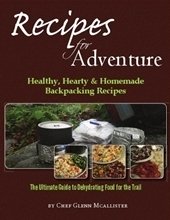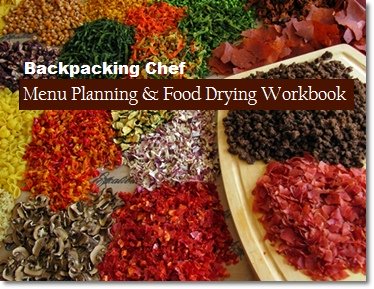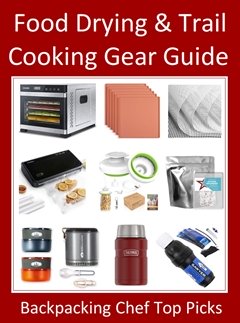How to
Dehydrate Pasta & Why
Precooking & dehydrating pasta makes rehydration in trail meals fast & efficient. This article explores how to dehydrate pasta in popular forms, including macaroni, spaghetti, linguine, fettuccine, pearl couscous, and orzo.
You’ll also find links to recipes with dehydrated pasta such as spaghetti with marinara sauce, mac & cheese, shrimp linguine, Thai peanut noodles, and many more.
How to
Dehydrate Pasta. Fast Facts:
- Cook pasta al dente according to package instructions.
- Drain and rinse pasta in cool water.
- Spread pasta loosely on dehydrator trays.
- Dehydrate pasta at 135°F (57°C) for approx. four hours.
Table of
Contents
Benefits of Dehydrating Pasta
When cooking pasta at home, you boil it in a big pot of salted water—a liter of water per 100 grams of pasta. Easy-peasy.
But on the trail, that’s a disadvantage:
- Uses too much fuel.
- Uses too much water.
- Requires pasta to be cooked separately from other dried ingredients.
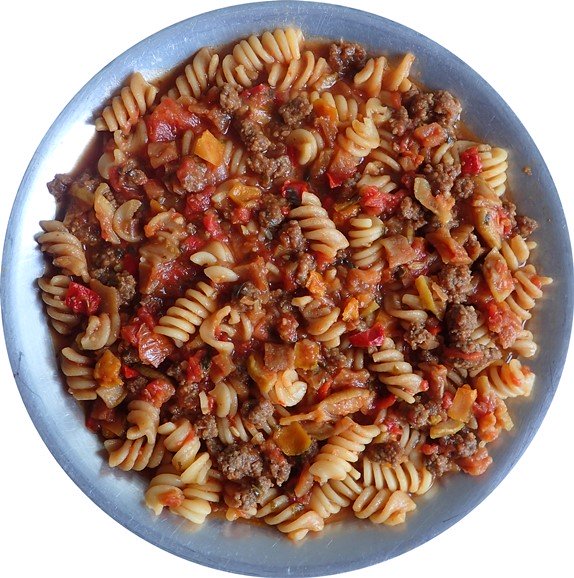
Photo: A backpacking meal prepared in one pot with dehydrated rotini, vegetable marinara sauce, and ground beef.
Precooking and dehydrating pasta:
- Uses less fuel and water on the trail.
- Rehydrates in the same pot or container with the other dried ingredients.
- Reduces overall cooking time, so you can get down to eating.
Essential for Cold-Soak Salads
Dehydrated pasta rehydrates well in cold-soak pasta salads like Tuna & Pasta San Marzano and Orzo Pasta Salad. Cold-soaked backpacking meals are great for making trail lunches in the summer without pulling out the stove and fuel.
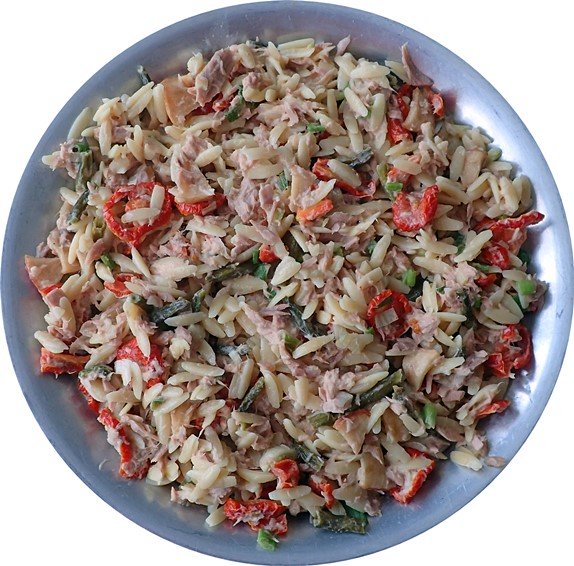
Photo: Orzo Pasta Salad rehydrated with cold water.
Note: You can’t cold-soak pasta that has not been precooked and dried, with the exception of Moroccan couscous.
Better for Freezer-Bag Cooking
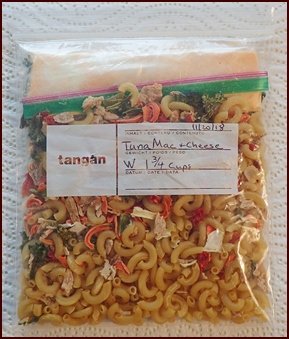
Photo: Dehydrated macaroni in bag with dried vegetables and tuna; ready to rehydrate with boiled water.
With dehydrated pasta, it’s easy to cook pasta-containing meals using the freezer-bag method, where you add boiled water to the ingredients in a freezer bag or Mylar bag. The boiled water rehydrates the pasta in minutes along with the other ingredients.
Note: There is not a sufficient duration of sustained heat to cook pasta from the box using the freezer bag method. It will turn out unpleasantly undercooked. The exceptions are Moroccan couscous and ramen, the latter of which is not actually pasta.
Best Pasta
to Dehydrate
For use in backpacking meals, deciding which pasta to use boils down to what you like, and packed volume. Dehydrated pasta turns out very close to its original size.
Large, tubular-shaped pastas like ziti, penne, and rigatoni, will take up a lot of space in your backpack compared to smaller-gauged pastas. That’s an issue if you’re trying to fit five days of meals in a bear canister.
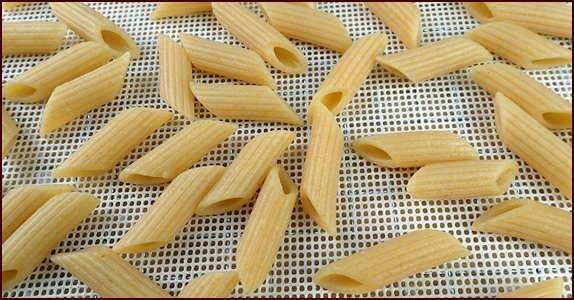
Photo: Penne pasta is not the best choice of pasta to dehydrate for backpacking meals, since it takes up a lot of space.
Farfalle (bow ties), rotini (spirals), and shells are good pastas to use if you choose the smaller-gauged varieties.

Photo: Dehydrated shells included in crab marinara. This meal is included in the Action Guide: Dehydrating 31 Meals.
Pastas like spaghetti, linguine, and fettuccine are perfectly fine to dehydrate. Just break the noodles into quarters before dropping them into the pot.
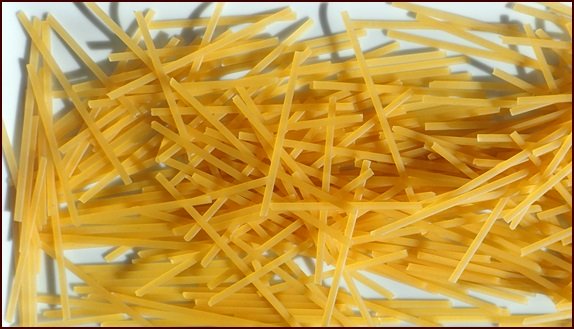
Photo: Linguine snapped into quarters before cooking and dehydrating.
Orzo and pearl couscous take up the least amount of space, but you may miss the bite of larger pasta varieties.
Photo: Cooked pearl couscous on silicone dehydrator tray.
And you can’t go wrong with good ‘ole macaroni.
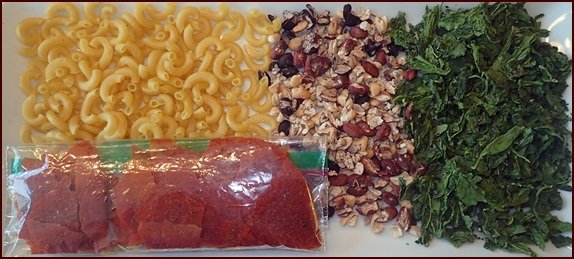
Photo: Precooked and dehydrated macaroni with beans, spinach, and marinara sauce.
How to
Dehydrate Pasta
The basic method of cooking pasta is similar for all pasta varieties.
Cook the pasta al dente (firm) according to package instructions. If the package says to cook the pasta for eight to ten minutes, go with eight minutes.
Note: Gluten-free pasta should be cooked to the left of al dente. Check it for firmness a couple of minutes before the time suggested on the box. It might be done in five minutes.
Steps:
- Use one liter of water per 100 grams of pasta.
- Bring water to a boil.
- Add a teaspoon of salt to the water.
- Drop the pasta into the boiling water and maintain a simmer for the duration of the cooking time.
- Immediately drain and rinse pasta in cool water. Rinsing stops the cooking and makes it easier to spread the pasta on dehydrator trays without it sticking to itself.
- Spread pasta loosely on dehydrator trays. Except for the smallest gauge pastas, use a mesh nonstick sheet rather than a solid nonstick sheet. This will speed up dehydration.

Photos: Cooked whole-wheat rotini on left, dehydrated on right.
- Dehydrate pasta at 135°F (57°C) for approximately four hours. Midway through the drying process, redistribute the pasta on the trays, pulling apart any pasta that is stuck together. No worries if some pasta remains stuck together; it will separate when you cook it on the trail.
Dehydrated pasta will be hard and brittle; very similar to how it was out of the box. It will weigh slightly less than before it was cooked.
Rehydrating Dehydrated Pasta Meals
With precooked and dehydrated pasta, you can cook the pasta in with the other ingredients. There’s no need to boil extra water to cook the pasta separately.
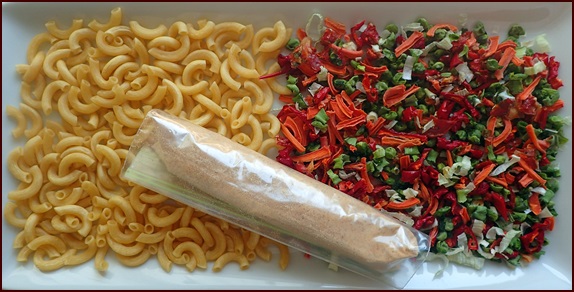
Photo: Dehydrated macaroni with dried vegetables and cheese sauce powders.
Rehydration methods covered in this section:
- Cook in Pot
- Cook in Mylar or Freezer Bag
- Cook in Thermos
- Cold Soak
Cooking in
a Pot
Add pasta with other dried ingredients to pot with required water for recipe. Soak five minutes, then bring to a boil for one minute. Transfer pot to an insulating pot cozy for 15-20 minutes.
Gluten-free pasta: Dehydrated gluten-free pastas are prone to get mushy when rehydrated on the trail. You'll get the best results if you add the gluten-free pasta to the pot after the water boils. Stir in the pasta, turn off the stove, and place pot in cozy.
If using powdered milk and cheese to make a sauce, stir the powders into the meal after you take the pot off the stove. This will make the pot easier to clean.
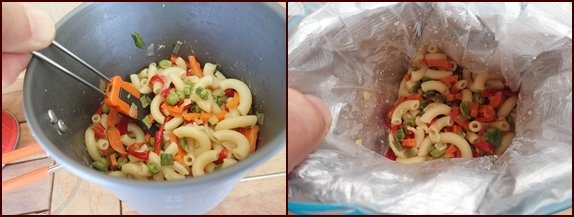
Photos: Veggie Mac & Cheese cooked in pot on left, cooked in freezer bag on right.
Explore More:
Cooking Mac & Cheese Meal in a Pot or Freezer Bag
Mylar Bag & Freezer-Bag Cooking
Add boiled water to dehydrated pasta meal in bag. Transfer bag to an insulating pouch cozy for 20 minutes. Or, place the bag back in the pot to hold in the heat. If the pot is small enough, you may be able to stretch the top of the bag over the edge of the pot when you are ready to eat.
Thermos Cooking
Add boiled water to dehydrated pasta meal in thermos. Use the quantity of water recommended in the recipe, but covering the dried ingredients with about an inch of water will usually be about right. Wait 20–30 minutes before serving.
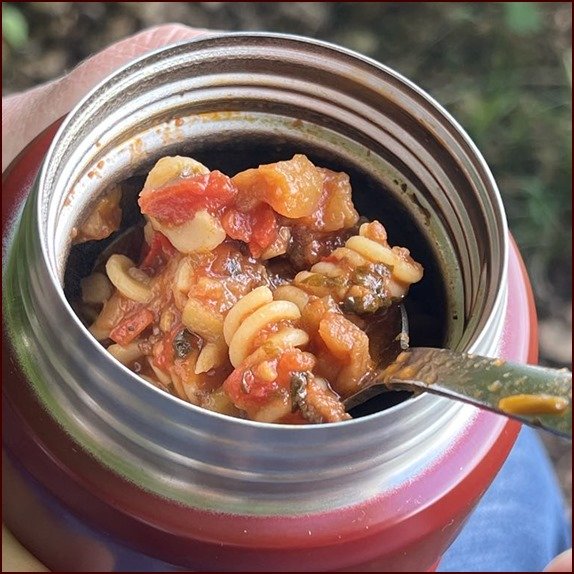
Photo: Thermos meal where the pasta was added 20 minutes before serving.
What if you are preparing the pasta meal in the morning to eat for lunch?
When soaked in boiled water for several hours, pasta will get soft. It still tastes good, and it’s convenient to add all the dried ingredients at the same time. But…
If you want perfect al dente texture, wait until 20–30 minutes before serving to add the pasta to the thermos.
Stir the pasta into the meal, and quickly replace the lid.
Turn the thermos upside down for a few minutes to ensure more liquid touches the pasta.
Explore More…
Cold
Soaking Dehydrated Pasta Salads
Add cold water to the dried pasta and other ingredients in a container with a tight-fitting lid. Wait at least one hour, but two to 2½ hours is better.
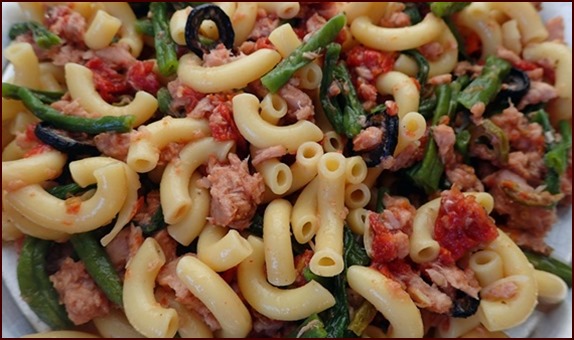
Photo: Tuna & Pasta Cold-Soak Salad.
Soaking Containers:
Thermos Food Jar: Better than any other container at keeping the meal cold (or hot) while it soaks. Ideal for road trips and day hikes, but may be too heavy at 13.7 ounces for multi-day backpacking trips.
Talenti Gelato Plastic Jar: Weighing less than 2 ounces, this is the choice of many ultra-light backpackers. After you polish off the gelato, this 16-oz. capacity jar works well for cold-soaking pasta meals because it has a tight-fitting lid with a wide opening for easy eating and cleaning. To help keep meals cold (or hot), make an insulating cozy for the jar to ride in.
Double-Seal Ziptop Bags: Add the ingredients and water to the bag, close, and place bag upright inside a backpacking pot.
Explore More…
Cold-Soaking Pasta & Rice Salads for Backpacking.
More Pasta Articles & Recipes
Explore more articles about how to dehydrate pasta in popular shapes with our favorite recipes.
Dehydrating Macaroni
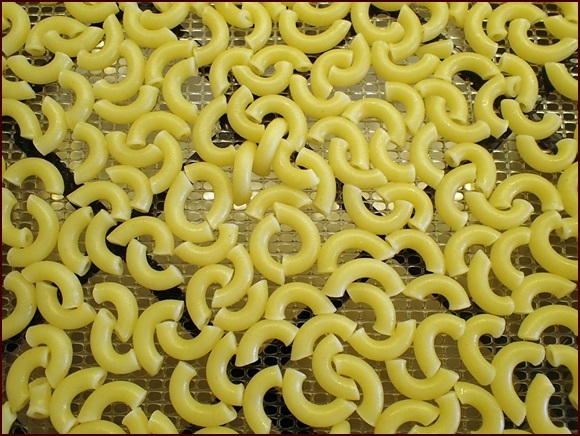
Photo: Cooked macaroni on mesh dehydrator sheet.
Article shows how to dehydrate macaroni, and it also includes mac & cheese recipes that can be cooked on the trail without precooking and dehydrating the macaroni. When using the thin-gauged pasta that come in boxed mac & cheese products, you can use it straight from the box if you cook it in a pot and maintain a boil for two minutes, followed by using an insulating pot cozy.
Explore More...
Dehydrating Spaghetti
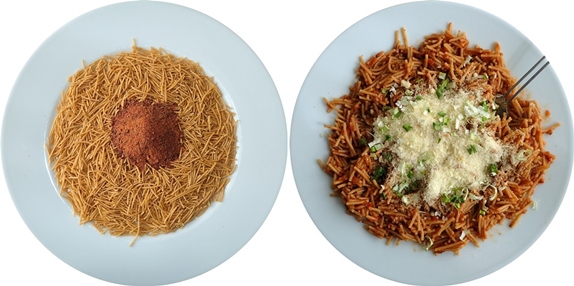
Photo: Dehydrated spaghetti with tomato sauce powder on left, rehydrated on right.
This Trail Bytes article show how to dehydrate spaghetti, and how to rehydrate it with marinara sauce powder.
Explore More...
Dehydrating Linguine
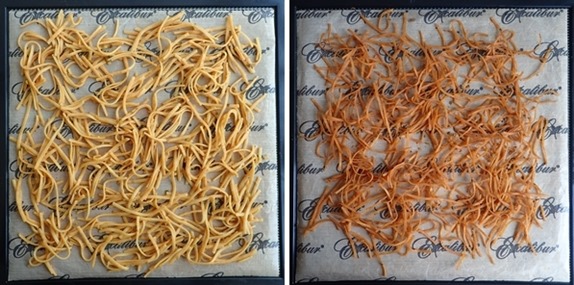
Photos: Cooked linguine coated with Thai peanut noodle sauce on left, dehydrated on right.
These articles show how to dehydrate linguine for two of our favorite backpacking meals. The linguine for both recipes was coated lightly with sauce before it was dried.
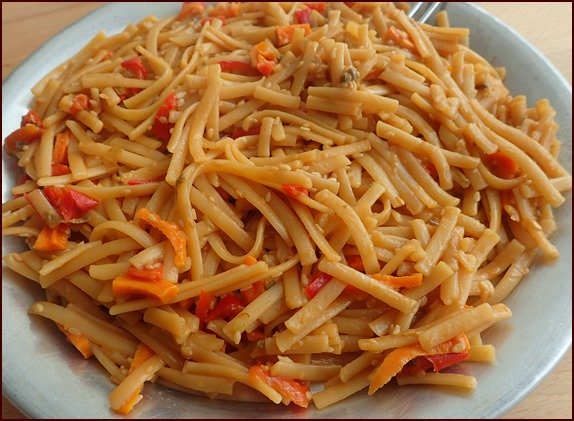
Photo: Thai peanut noodles, rehydrated.
Explore More...
Dehydrating Fettuccine
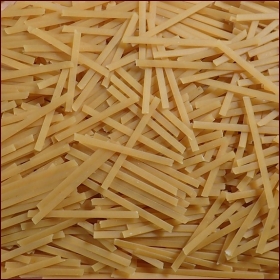
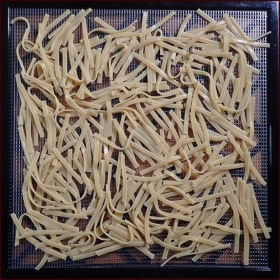
Ingredients:
- 1 lb. package of fettuccine noodles (454 g)
- 4 quarts of water (3.8 liters)
Break fettuccine noodles into quarters and set aside until the water boils.
Bring salted water to a rapid boil and dump in fettuccine noodles. Use a tablespoon of salt in the water.
Reduce heat to medium-high and cook lentils at a gentle boil to al dente texture, about 11 minutes.
Drain and rinse with cool water to stop cooking.
Dehydration:
Spread cooked fettuccine loosely on dehydrator trays using mesh sheets.
The usual temperature for dehydrating pasta is 135°F (57°C), but since I dried the fettuccine in the same load with the lentil bolognese sauce, I dried it at 145°F (63°C). Either temperature is fine.
A one-pound package of cooked fettuccine takes up four Excalibur dehydrator trays.
Fettuccine dries in about four hours and will be hard and snappy. It will weigh a little less than it did before you cook it.
Yield:
A one-pound package of fettuccine (454 g) weighs 439 grams after cooking and drying. That’s enough to make 6–8 backpacking meals.
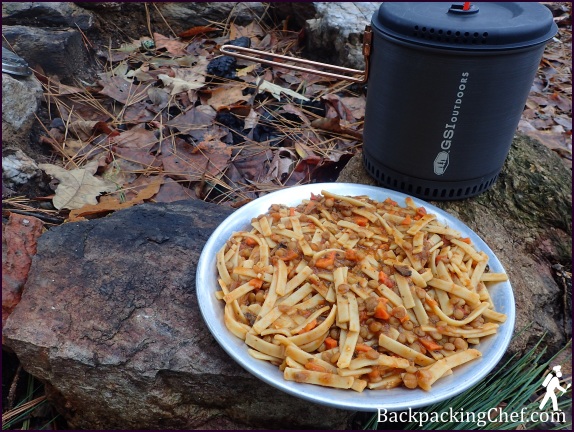
Fettuccine is a great pasta to pair with my lentil bolognese recipe. When rehydrated, fettuccine retains a firm bite in the meal.
Explore More...
Dehydrating Orzo
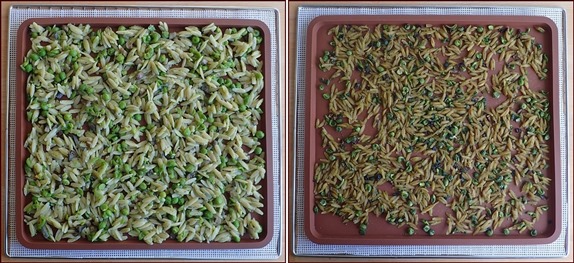
Photos: Dehydrating a complete pasta meal which included orzo, peas, and mushrooms.
This article shows how to dehydrate orzo cooked like pasta or rice, with several orzo backpacking recipes.
Explore More...
Dehydrating Pearl Couscous
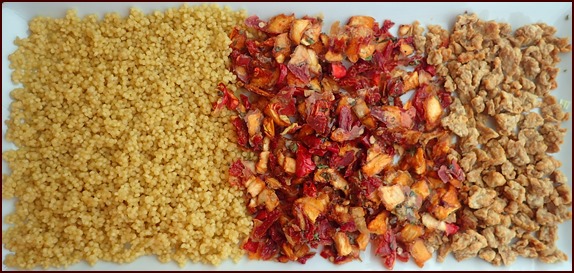
Photo: Dehydrated pearl couscous, peach salsa, and chicken.
Dehydrated pearl couscous rehydrates nicely in cold-soak salads, but it’s also delicious in hot meals.
Explore More...
Zesty Black Bean Salad with Pearl Couscous
Pearl Couscous with Peach Salsa & Chicken
Dehydrating Pasta Sauce
Photo: Dehydrating tomato sauce leather.
Now that you know how to dehydrate pasta, you’ll want to make some saucy meals with dehydrated tomato sauce leather or powder.
Explore More…
How to Make Tomato Sauce Leather
How to Make Tomato Sauce Powder
Shop Amazon
Dehydrator accessories for dehydrating pasta.

Left: Cosori Dehydrator, Stainless Steel, 6-Trays
Middle: Silicone Dehydrator Trays with Raised Edges, 11.8" x 10.8", 6-Pack
Right: Silicone Mesh Dehydrator Sheets, 14” x 14”, 12-Pack
Disclosure: As an Amazon Associate, Backpacking Chef earns from qualifying purchases.
Share this page with friends on social media.
Free E-book & Newsletter
Free with Trail Bytes subscription.
Dehydrating Food from A–Z




